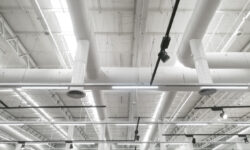Don’t touch that dial! At least, not unless you want to risk the wrath of your workforce. The ideal workplace temperature is hotly debated, but it’s about more than just comfort. Workplace temperature regulation directly impacts productivity. Here’s why your building should ensure that you regulate the environment for maximum comfort and efficiency.
Read more →Anyone who owns a commercial building knows that ductwork is an integral part of the property’s operations. In order to operate at maximum efficiency, your HVAC ductwork needs to be designed, sized, and installed correctly. Proper duct size is all too often an overlooked feature of commercial HVAC systems. The role that duct sizing and material play in maintaining a safe, comfortable environment should not be underestimated. Having the right size and material for your ducts will maintain comfortable conditions, improve indoor air quality, minimize energy losses, and lower your heating and cooling bills, as well.
Read more →Regular HVAC maintenance in your commercial building is a responsibility you owe to your tenants and employees, but you owe it to yourself, as well. In fact, properly maintained systems can provide up to 25 years of dependable performance. Commercial-grade HVAC equipment such as air conditioners, furnaces, heat pumps, and boilers are very expensive to replace. On the other hand, regular preventative maintenance is relatively inexpensive. From reducing utility costs to improving your air quality, professional HVAC maintenance is financially advantageous and time-saving.
Read more →Heating, ventilation, and air conditioning (HVAC) systems are so commonly used in American commercial buildings, schools, data centers, homes, and other places that you probably don’t notice them unless the setting is too cold or the system breaks. You’ve probably never given much thought to the history of HVAC installations! Whether you notice HVAC systems or not, Americans spend vast sums on them. The Energy Information Administration reported in 2015 that 48 percent of energy consumption was related to heating and cooling costs! Though HVAC systems are everywhere, how much do you know about their history?
Read more →Chillers use up about 20% of the total power generated in the country. What’s more, they can increase up to 30% additional energy usage of a building due to operational inefficiencies. This costs companies and building facilities billions yearly. Today, commercial buildings install efficient HVAC systems with an aim to improve a building’s sustainability and performance. Which brings us to water-cooled chillers, an essential HVAC component for a wide variety of commercial facilities. Continue on to learn more about water-cooled chillers, and find out if it’s the right choice for your facility.
Read more →One common challenge that commercial properties face is proper air control, which can be solved by packaged HVAC systems. But, what’s the best way for facility managers to heat and cool a building? First, they need to consider all the HVAC systems that are available and which fits the property’s needs. For example, packaged HVAC systems are best for commercial spaces. They offer energy savings, easy maintenance, and a quieter building. Read more to learn more.
Read more →Geothermal systems work similarly to other HVAC structures. However, there is one major difference. Geothermal systems use the ground rather than air to absorb or release heat. So, if you are considering installing a geothermal heat pump (GHP) system for your facility or business, pay close attention. Here are five things you need to know about geothermal systems.
Read more →According to a study by the U.S. Department of Energy, HVAC systems are the largest users of energy in commercial buildings. That being said, the cost of running your building’s HVAC system will be among your greatest expenses, so it’s important to carefully select the components of your HVAC design.
Read more →As the world develops and grows, so does the need for proper climate control for commercial HVAC systems. New, original architectures pop up seemingly overnight, and with them comes another huge challenge. So, how are people supposed to manage climate control in uniquely-shaped and wholly different buildings, the likes of which they’ve never seen before?
Read more →Around since the late 1880s, ceiling fans have become a staple in U.S households. It was one way to make rooms more comfortable. They lost a bit of popularity in the 50s as airconditioning came to our homes. However, in the 1970s during the energy crisis, they made a comeback. To this day, they still remain in demand and a common household fixture. Yet, with technology today, what are the benefits of ceiling fans? Do we actually need them? Read on to find out.
Read more →









